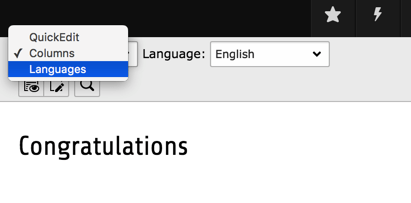web_layout¶
Configuration options of the "Web > Page" module.
allowInconsistentLanguageHandling¶
-
allowInconsistentLanguageHandling¶ -
- Type
- boolean
By default, TYPO3 will not allow you to mix translated content and independent content in the page module. Content elements violating this behavior will be marked in the page module and there is no UI control (yet) allowing you to create independent content elements in a given language.
If you want to go back to the old, inconsistent behavior, you can toggle it back on using this switch.
Example: Allow inconsistent language modes¶
Allows to set TYPO3s page module back to inconsistent language mode
mod.web_layout.allowInconsistentLanguageHandling = 1BackendLayouts¶
-
BackendLayouts¶ -
- Type
- array
Allows to define backend layouts via Page TSconfig directly, without using database records.
Example: Define a backend layout¶
mod.web_layout.BackendLayouts {
exampleKey {
title = Example
icon = EXT:example_extension/Resources/Public/Images/BackendLayouts/default.gif
config {
backend_layout {
colCount = 1
rowCount = 2
rows {
1 {
columns {
1 {
name = LLL:EXT:frontend/Resources/Private/Language/locallang_ttc.xlf:colPos.I.3
colPos = 3
colspan = 1
}
}
}
2 {
columns {
1 {
name = Main
colPos = 0
colspan = 1
}
}
}
}
}
}
}
}defaultLanguageLabel¶
Warning
Note that this option has largely been superseded by site configuration since TYPO3 v10 and will only work in the Backend for a "NullSite". For instance, a global sysfolder in the page tree without an attached site configuration. Once a page tree has a site configuration, the default language label is set from the site configuration's language settings and this option will have no effect at all.
-
defaultLanguageLabel¶ -
- Type
- string
Alternate label for "Default" when language labels are shown in the interface.
Overrides the same property from mod.SHARED if set.
defLangBinding¶
-
defLangBinding¶ -
- Type
- boolean
- Default
- 0
If set, translations of content elements are bound to the default record in the display. This means that within each column with content elements any translation found for exactly the shown default content element will be shown in the language column next to.
This display mode should be used depending on how the frontend is configured to display localization. The frontend must display localized pages by selecting the default content elements and for each one overlay with a possible translation if found.
hideRestrictedCols¶
-
hideRestrictedCols¶ -
- Type
- boolean
- Default
- false
If activated, only columns will be shown in the backend that the editor is allowed to access. All columns with access restriction are hidden in that case.
By default columns with restricted access are rendered with a message telling that the user doesn't have access. This may be useless and distracting or look repelling. Instead, all columns an editor doesn't have access to can be hidden:
EXT:site_package/Configuration/page.tsconfigmod.web_layout.hideRestrictedCols = 1Copied!Attention
This setting will break your layout if you are using backend layouts.
localization.enableCopy¶
-
localization.enableCopy¶ -
- Type
- boolean
- Default
- 1
Enables the creation of copies of content elements into languages in the translation wizard ("free mode").
Example: Disable free mode button for localization¶
mod.web_layout {
localization.enableCopy = 0
}localization.enableTranslate¶
-
localization.enableTranslate¶ -
- Type
- boolean
- Default
- 1
Enables simple translations of content elements in the translation wizard ("connected mode").
Example: Disable "connected mode" button for translation¶
mod.web_layout {
localization.enableTranslate = 0
}noCreateRecordsLink¶
-
noCreateRecordsLink¶ -
- Type
- boolean
- Default
- 0
If set, the link in the bottom of the page, "Create new record", is hidden.
tt_content.preview¶
-
tt_content.preview¶ -
- Type
- boolean
It is possible to render previews of your own content elements in the page module. By referencing a Fluid template you can create a visual representation of your content element, making it easier for an editor to understand what is going on on the page.
The syntax is as follows:
EXT:site_package/Configuration/page.tsconfigmod.web_layout.tt_content.preview.[CTYPE].[list_type value] = EXT:site_mysite/Resources/Private/Templates/Preview/ExamplePlugin.htmlCopied!This way you can even switch between previews for your plugins by supplying
listas CType.Note
This only works, if there is no hook registered for this content type, you may want to check this section in the System > Configuration module:
Search for registrations of this hook$GLOBALS['TYPO3_CONF_VARS']['SC_OPTIONS']['cms/layout/class.tx_cms_layout.php'] ['tt_content_drawItem']['content_element_xy'];Copied!
Example: Define previews for custom content elements¶
mod.web_layout.tt_content {
preview.custom_ce = EXT:site_mysite/Resources/Private/Templates/Preview/CustomCe.html
preview.table = EXT:site_mysite/Resources/Private/Templates/Preview/Table.html
preview.list.tx_news = EXT:site_mysite/Resources/Private/Templates/Preview/TxNews.html
}
